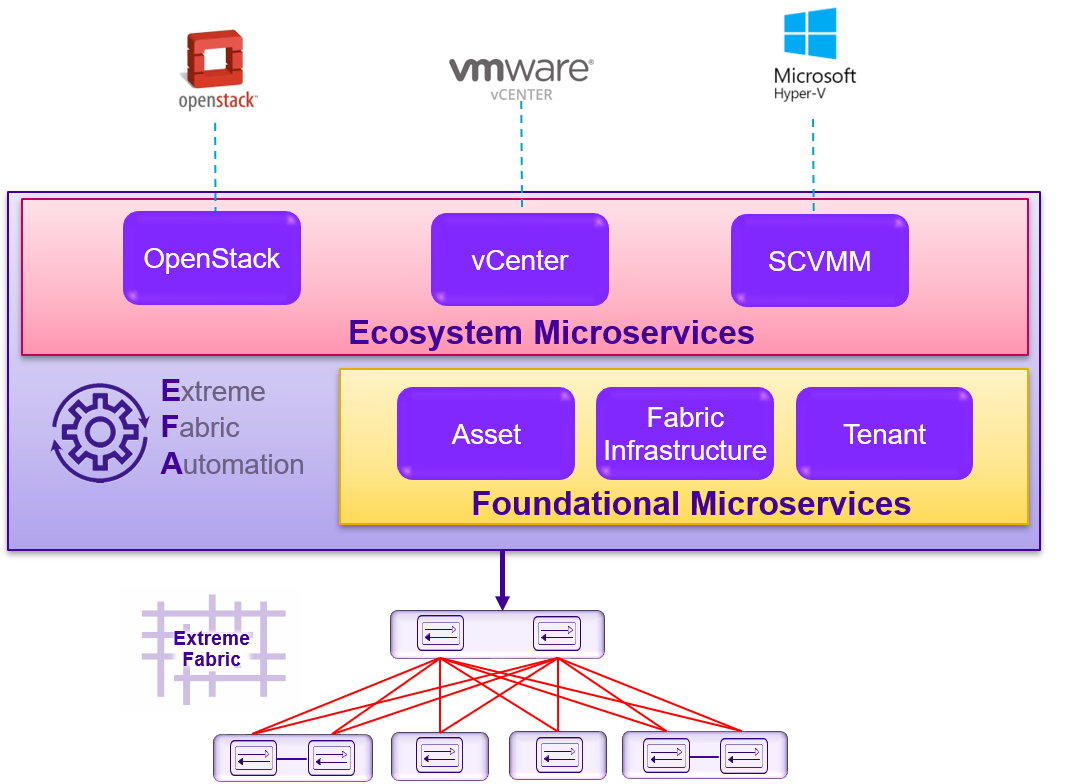Extreme Fabric Automation Overview
Extreme Fabric Automation (EFA) is a microservices-based application that manages the life cycle of IP Fabric CLOS and Small Data Center deployments. All of the microservices support REST APIs that are detailed by OpenAPI.
EFA offers unique flexibility in supporting multiple IP Fabric topologies based on a BGP underlay with a BGP/EVPN overlay:
- Small Data Center Fabric (non-CLOS topology from a single switch pair up to four switch pairs)
- 3-stage CLOS (Leaf / Spine)
- 5-stage CLOS (Leaf / Spine / Super Spine)
Tenant Network onboarding services are supported on all the topologies, which allows you to create connectivity for devices that are connected to the fabric, such as compute (servers), storage, and any other connectivity needed such as external routers or gateways.
Life cycle management of the Fabric allows you to add or delete devices to the Fabric after Day 0. Similarly, you can add or remove Tenants as necessary. Key ecosystem integrations streamline Tenant and network provisioning by way of VMware vCenter, Microsoft System Center for Virtual Machine Management (SCVMM) and OpenStack with ML2 and L3 service plugins.
EFA Core Services and Integrations
EFA comprises several core containerized services that interact with each other and with other infrastructure services to provide the core functions of IP Fabric automation.
| Service | Description |
|---|---|
| Asset Service | Provides the secure credential store and deep discovery of physical and logical assets of the managed devices, and publishes the Asset refresh and change events to other services. |
| Fabric Service | Helps orchestrate and visualize BGP-EVPN-based 3-stage and 5-stage IP Clos and Non-Clos fabrics. |
| Tenant Service | Helps manage the Tenants, Tenant Networks, and end points, fully leveraging the knowledge of Assets and the underlying fabric. |
| Inventory Service | Acts as an inventory of all the necessary physical and logical assets of the fabric devices. All other EFA services rely on inventory service asset data for their respective configuration automation. |
| System Service | Provides EFA system utilities such as support-save, backup, and restore. |
| Notification Service | Sends events, alerts, and task updates to external entities. |
| Authentication Service | Enforces a security boundary between northbound clients and downstream operations between EFA and SLX. |
| Authorization Service | Validates users and their credentials. |
EFA also provides a microservice for each ecosystem integration. This architecture permits rapid development and integration of different ecosystem integrations. Each operates independently to externally integrate while using the same underlying services to interact with the IP Fabric.
| Ecosystem | Description |
|---|---|
| VMware vCenter | The vCenter integration provides connectivity between EFA and vCenter using a REST API as documented in the VI SDK. EFA does not connect to individual ESXi servers. All integration is done through vCenter. |
| OpenStack | OpenStack is a cloud operating system that controls large pools of compute, storage, and networking resources throughout a data center. |
| Microsoft Hyper-V | The Hyper-V integration supports networking configuration for Hyper-V servers in a data center, manual and automated configuration updates when VMs move, and visibility into the VMs and networking resources that are deployed in the Hyper-V setup. |
The following figure illustrates the application functionality in provisioning and discovery.


